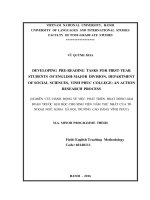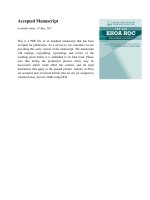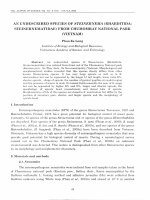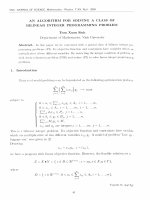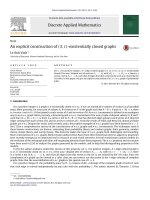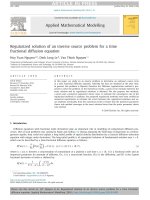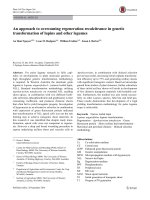DSpace at VNU: An application of random process for controlled object identification with traffic delay problem
Bạn đang xem bản rút gọn của tài liệu. Xem và tải ngay bản đầy đủ của tài liệu tại đây (5.18 MB, 9 trang )
VN U Journal of Scicnce, M athem atics - Physics 24 (2008) 101-109
An application of random process for controlled object
identification w ith traffic delay problem
V u Tien Viet*
D ep a rim en t o f M athem atics, M echanics, Inform atics, C ollege o f Science, VN Ư
334 N guyen Trai, H anoi, Vietnam
R eceived 23 January 2007; received in revised form 20 March 2008
A b stra ct. In the articlc proposed an effective method estim ating transfer function model o f
controlled plant including dead-time delay, based on slochatstic tim e series o f inpul-output
signals.
The model slm cture is modified with parameters optim ized until the model error
b ccom cs ”w h itc-n oisc” series that with inough srnal auto-corrclation function.
1. Propose
The Real signals w h ich occur in the control process alw ays im lpy influences o f m any random
factors, so the D irective O bject Identification Problem is often related to random process.
M athem atically, th e C ontrolled O bjcct Identification problem is th e problem th at predicts the
trend o f R andom Proccss: y{t ) — f { t ^ ĩ i ) -ị- v{t ) , w here t - tim e; u - vector o f non-random input
variables; / ( i , ĩi) - regressive function that reflects the trend o f non-random process or is the m odel o f
the identification pro b lem ;
v{t)
- random error.
T he T heory o f Prediction and Identification has been studied and developed w ith thousands of
scientific w orks m ade p u b lic since last century. We can find th e fundam ental results o f studies o f
statistics and prediction in [1,2], o f kinetics system identification in detail in [3,4 .
To use linear algebra m ethods, wci often try to changc th e regressive m odels into linear com
bination fo n n s o f coefficients:
f{t^u) —
5 w here Ci - param eters,
- given
com ponent functions. B y usin g th is m odel, th e Param eter Identification Problem can be solved easily.
H ow ever, th is m odel is n o t used to solvs the analysis and synthesise pro b lem o f system s and w e have
to transform th is m odel into th e fom i o f sets o f state equations (sets o f C auchy differential equations)
or tran sfer function fom i. There is a close, easy to exchange relation betw een set o f state equations and
tran sfer function. T h e tra n sfe r fu n ctio n ’s m odel o f controlled object is often in th e follow ing form;
rT r
\
W { C , s) =
bjjiS
Òq “h 5 ] 5
^
^
—r s
^
^
^ ^
/1 \
w here Ó' - com plex num ber, r ^ 0 - the dead tim e delay; r a ^ n - degree o f num erators and denom inators;
c = { r , 6o, 6i
, bjrv^ ao, a
i , a-n} - vector o f param eters to be determ ined.
In th e classic w o rk s o f identification, all th e authors concentrated on developing identification
m ethods based on pure p o ly n o m ial fraction m odels w ith o u t the dead tim e delay com ponents (i.e. set
Coưesponding author. E -m ail: vutienvict.56@i]mail.com
101
102
Vu Tien Viet / VNƯ Journal o f Science, Mathematics - Physics 24 (2008) Ỉ0Ỉ-109
r — 0). In fact, exists r ^ 0, w e n o rm ally tiy to use approxm iate po ly n o m ial fraction m odels w ith
h ish e r degrees o f m , n to in crease th e m odel accuracy. W ith th is approach, th e object identification
problem w ithout dead tim e d e la y is co n sid ered to b e com pletely solved in th eo ry [1,4 .
In fact, how ever, ap p ly in g th e p u re p o ly n o m ial fraction m ethods to the objects w ith dead tim e
delay is reluctant and in effectiv e in co n tro llin g tech n o lo g y p rocesses such as energy, m etallurgy,...
because m ost o f the ob jects o b v io u sly h ave th e dead tim e delay. To have th e necessary m odel accuracy,
w e norm ally increase th e deg ree o f p o ly n o m ial fraction to a great value, and therefore m aking the
s}Tithesise problem o f sy stem s m ore com plex, even lose its essence.
D isregarding th e c h ara cteristics o f dead tim e delay o f an object is one o f th e reasons th a t leads to
a great num ber o f research d irectio n s o f control th e o ry im practically developed, even caused a ’’crisis”
in the previous cen tu ry [5]. To accu rately reflect th e controlled object, w e have to consider dead tim e
delay as an existing p a ra m e te r in clu d ed in th e m odel. W hereas, clearly, th e m odel is non-Iincar for the
param eters. In this case, classic m eth o d s are e ith er ineffective or inapplicable.
Because o f the ab o v e reaso n s, in order to increase th e applicability, w e recom m end a controlled
object identification m eth o d b ased on u sin g d ircc tly m odel ( 1) along w ith the dead tim e delay r and
other param eters. The fo llo w in g m ethod is b ased on considering th e tim e response o f the object as a
random data series.
2. Estimation of the object m odel from output response data series
Suppose the co n tro lled ob ject has w eig h t fiintion w{ t ) w ith cfFect input u{t)~ predeterm ined,
output response is m easu red : y { t ) — x { t ) + v { t ) , w h ere v { t ) - additive noise (figure 1).
v ít )
u(t)
M t) , .
•
.
y[J4 '
-- ^
Fig. 1. Linear control system under random effect.
W ithout loss o f generality , w e restrict v { t ) ^ u { t ) b e in g th e non-in terco irelatio n scalars, w here
v{t) is W hite N oise, u { t ) is step p u lse:
« { « ) = ( '’
^ '
[1
" i™
w h en
( 2)
Í > 0
Form erly [3,4], so as to solve th e moQol estim atio n problem , w e based on po p u lar relation
betw een output response x { t ) o f o b ject and in p u t signal u{t)\
x{t) = [ w { ^ u { t - Ẹ ) d ^
Jo
(3)
w here w{ t ) is the w e ig h t fu n ctio n .
From (3), w e esta b lish th e P roblem o f D efin in g w eig h t fiintion w { i ) upon least square condition:
\ 2
[
Jo
(y{t) - [
\
Jo
dt
m in
(4)
Vu Turn Viet / m ư Journal o f Science, M athematics - Physics 24 (2008) Ỉ0Ỉ - Ỉ 09
103
and then, define the tran sfer function i y ( 6) from th e w eig h t fo ntion w{ t ) .
If wc param eterize the funtion w{ t ) in the fom i o f lin ear co m b in atio n , the (4) problem w ill
bccom c linear to coefficients and can be solved easily. H ow ever, in th is w a y it is com plcx to sclcct
com ponent functions and causes the problem biiigcn and th erefo re m ::kcs th e problem illconditioncd.
To avoid this draw back, w e rccom m cnd d ircctly u sin g th e m o d el o f tran sfer function in fom i
(.1) and salve the m odel estim ation problem based on th e inverse l.a p la c e transform ation. Indeed, if
w e co n sid er argum ents in the L.aplace imatỉc dom ain, w e obtain:
.—rs
X ( C , 6-) = VK(C, s ) . U{ s ) ^ ^0 +
+ ... +
1 -Ị-' + ... + cijiS
w here x { s )
^
(5 ^
L { x { t ) } , v y (c .s ) ^
L { w { t ) } , u { s ) = L{u{t ) }- , s - com plcx variable; L{.}
roo
- notation fo r Laplacc transform ation; G{ s) = L { g { t ) } = /
g{t ) e~' ' ^dt - Laplace transfom iation,
Jo
from any g{t ) function in real dom ain (g{t) —
^ 0) into co rrcsp o n d in ơ im aac G{ s ) in com plex
dom ain.
A ccording to th e Inverse Laplacc transform ation, in [6 ] w e infcrcd a sim ple form ula to computti
tim e response x { t ) from its Laplacc imaac:
1
rgijoo
X (C ,s)e^^ds= ^
7T 7 o
0 =
27rj Jg-j oo
P{C, Lo) cos{ujt)(Lj
(6 )
w h ere g ' converging ab scissa o f Laplace integral ( if objects are stab le, w e can select ^ > 0 sm all
enough, for instance Q — 0.01);
X{C,cu
jo c ).
=
—1 , P ( C ,o j i =
R e { X ( C ,c j -\' j o c ) } - the real part of
Sclect the u p p er lim it (u^m ) o f th e integral w h ic h is b ig enougli, th en trasform into approxim ate
sum fonn, w c obtain:
x { C , t) = — V P ( C , LUr) COs{uJrt)
7T
^
r -^1
--
(7)
w here M “ the n u m b er o f d iscrete points in frcq u cn cy range: UJ = 0 ^ COMFrom here, w e obtain square error betw een o u tp u t response and real data:
ơ ^‘ { C ) =
fT
/ [y{t) — x{ C, t ) ] ' ^ d t
Jo0
mm
c
w here T - the am ou n t o f tim e to observe the random ou tp u t d ata series o f real objects.
R egarding the d iscrete points o f tim e series, w e o b tain m in im izatio n objective function:
m in
(8)
w here N - the n u m b er o f d iscrete points in an interval o f observed tim e: Í = 0 ~ T .
O bjective fu n ctio n ’s valu e a ^ (C ) is determ ined after a c o m p u tin g process in the follow ing
order:
c
— > W{C, g-\-jio) — ^
X (C ,
Ơ + jc j) — ^ P{ C^ u j ) — > x { C ^ t ) — ^ (J^(C). Therefore,
a ^ (C ) is a com putable function and is continuous and d ifferen tiab le every'w here. O n the other hand, is
obvious no n -lin ear fu n ctio n s to param eters and esp ecially h ave th e co m p lex cleft (ravine) characteristic.
W ith these characteristics, th e m ost effective m ethods to solve th e m in im ized problem (8 ) is to apply
”c le ft-o v c f’ optim ization algorithm [7,8 .
Vu Tien Viet / VNU Jo u ’Tial o f Science, Mathematics - Physics 24 (2008) I0Ỉ-109
104
T he so lu tio n to th e ( 8 ) problem w ith the selected structure ( m , n , q) o f m odel (1) give us an
optim al estim atio n a;(C*, t) w ith ĩj{ti) series, and to s e th sr w ith th e optim al tran sfer function W^(C*. s)
respectively.
3. Determ ine the optimal estim ation model
A s above, w ith each selected struture ( m . n , q), an optim al solution is output response m odel
a;(C*, t) and th e W { C * , s) optim al tran sfer function, respectively. D epending on the selected (m , n , q)
com bination, T h ere are infinite structures o f the m odel. So, th e facing problem is to find a (rn, n , q)
struture so th a t th e co ư esp o n d in g solution to th e problem (8 ) b rings out the response x (C * , t), w hich
is the p ro p er estim atio n for th e y{ti) tim e series.
A cco rd in g to [1,2], the m odel is cosidered as a p ro p er estim ation if th e obtained error series
betw een the given m odel and tim e series becom o a radom distrib u tio n range in the fonn o f "w hite
noise” . A ssum e a a significance level, the m odel is considered to be accurate if Goưelation coefticients
value ri o f erro r series satisfy th e follow ed condition;
nl ^ u^ / V N
(9)
w h ere U a - is th e lim ited value obeying the norm al d istrib u tio n rules, N - the n u m b er o f data sets o f
series.
O n the o th e r hand, th e (1) mode] is fractional, so if w e increase th e (m , n) degrees its accuracy
w ill increase as a result. Particularly, q is the n o n static degree o f m odel, it depends on th e behaviour o f
output response and is equal to the degree o f th e asym ptote o f output response. (J = 0 if the asym ptote
o f output respo n se is horizontal asym ptote.
<7 =
1 if the asym ptote o f output response is oblique
asym ptote, q > I i f output has no asym ptote. In fact, Ọ < 1 in m o st eases.
To d efin e th e global optim al estim ation m odel, th e steps to solve th e identification problem arc
as follow s:
1. S elect th e degree o f q and fix it from th e output resp o n se’s behaviour.
2. E xp lo rativ ely select values o f d en o m in ato r’s degree n, and values o f n om inator’s degree
m = n — I sim ultaneously.
3. F o r each selected { m, n, q) structure w e solve th e (8 ) estim ation m odel problem .
4. W ith th e respective
s) and x { c * , t) obtained, w e detcm iin e error scries and check
the condition u p o n m odel suitability.
5. I f th e condition is satisfied, th e obtained m odel is optim al and th e respective W { C * , s)
tran sfer iu n c tio n is th e solution to th e identification problem .
6 . I f th e m odel is not suitable, w e w ill select other m odels w ith m and n ’s degree gradually
increased and reo eat from step 3.
4. E x a m p le
S uppose th e output signal o f an im plem ent controlled object is the step p u lse in form
th a t tim e, from
i
ti
Vi
1
0.0 1 0 0
- 0 .0 0 2 3
th e output, th e m easured response signal in form o f tim e series
2
0.2054
0.0060
3
0.4008
0.2540
4
0.5962
0.6000
5
0.7916
1.0641
6
0.9870
1.3125
7
1.1824
1.4700
8
1.3778
1.4126
(2). A t
is as follows:
9
1.5732
1.2500
10
1.7686
1.2191
105
Vu Tien Viet / VNƯ Journal o f Science, Mathematics - Physics 24 (2008) Ỉ 0Ỉ - Ỉ 09
i
u
i
tr
in
11
1.9G40
1.0800
12
2.1594
1.0830
13
2.3548
1.0127
14
2.5502
1.0300
IG
2.7457
0.9900
16
2.9411
1.0310
17
3,1365
0.9407
J8
3.3319
0.9900
19
3. r/2 73
0.9600
20
3.7227
0.9740
21
3.9181
0.9Õ00
22
4.1135
0.9900
23
4.3089
0.9560
24
4.5043
0.9960
25
4.6997
0.9539
26
4.8951
1.0400
27
Õ.0905
0.9680
28
5.2859
1.0510
29
5.4813
0.9900
30
5.6767
1.0211
The G raph o f the tim e series y{t ) obtained from cxperiem cnt is show n in figure 2
Ỉ IV
\
i \
!
\ '•
ị ị
-> ị
[ i
:ị
Fig. 2. The curv'e o f output response data scries o f dircclivc object.
We id en tify the tran sfer function o f objcct b ased on m odel (5) b y solving th e (8 ) problem w ith
diftcrcnt structures. The im age o f input signal step pulse; u { s ) = 1 / s . T he b eh av io u r o f the data
series above is co ư csp o n d in g to the nonstatic degree w here <7 = 0. H ence, w e only have to selcct the
suitable degree o f n um erator and denom inator ( m , n ) o f transfer function (5), H aving selected the
( r n ,n ) structure, w e solve the (8 ) problem by the ”cleft-over” algorithm [7,8'
o .ái
p.
“1 / \
t
-vis.
0^
t>,7.
b.
a
o4
a,sf
t
6.0
f
0^ ủ:
C.Í
G.o
d.
c.
Fig. 3. The error series of models.
Vu Tien Viet / VNƯ Journal o f Science, Mathematics - Physics 24 (2008) Ỉ 0Ỉ - Ỉ 09
Ỉ0 6
Strutnres o f tested models'.
1. T he first struture, w e choose; 771 = 0, n — 1. The rcspectivc optim al m odel is:
. e - 0 .3 6 4 .
^
l +
1+0,1675
T he e ư o r series b etw een the output response X i(c * , t) and the m easured data is on flizurc 3-a.
T he
root-m ean-squarc
Eưor of
the
m odel is ã = 0, 1429.
o bviously in c o ư e ct because th e condition \ri\ ^
B y u sin g this m odel, the estim at
>/]V is d e a r ly not satisfied.
2. T he second struture, w c choose: m = 0, n = 2. The optim al m odel is:
W o(C * s) = ______ - ______ _______________________________g - 0,108.,
’ ’
l + a i 5 + a2s2'
l + 0 , 2 3 9 s + 0, 123s2'
T he error series b etw een the output response X 2 {C*^ t) and the m easured data is on figure 3-b.
T he root-m can-square E rror o f th e m odel is Ỡ “ 0, 0682. T his m odel briniĩs out the in c o ư e ct estim ation
because the condition \ri\ ^ U 2 . / \ / 7 ĩ is still not satisfied.
3. W ith th e third struture, w e choose; m — 1, n — 3. T he optim al m odel is:
,
6o( l + ?ii6')
0 , 9 8 5 ( 1 + 1,1666')
(1 -I- a i s + a 26 '2 ) ( l + a s s ) ■
(1 + 0, 3 6 5 s + 0, 0986-^)(l + 0, 6836') ■
T he error series betw een the output response ,X3(C*, t) and the m easured data is on figure 3-c.
T he
root-m can-squarc
E rror o f
th e
m odel is Ỡ = 0, 0342. T h is m odel brings out the nearly
e s tim a tio n , th e c o n d itio n u p o n m o d el su ita b ility |r,;| ^ U ẹ . / \ Í N is n e a rly sa tisfie d .
4. T he fourth struture, w e choose: m = 2, n = 4. The optim al m odel is;
(1 + a i s + a 2 S^) {ỉ + a a s + 045^)
1, 001(1 + 0, 716s + 0, 37s2)
“
. - 0,183.
(1 + 0, 202s + 0, 0 8 4 s 2 )(l + 0, 5 4 5 s + 0, 414s2)
T he e ư o r series b etw een the output response a;4( c * , t) and the m easured data is on figure 3-d.
T he root-m ean-square E ư o r o f th e m odel is o' — 0, 0212. T his m odel brings out the co ư cct estim ation
since the condition upon m odel su itab ility Ir^l ^ U i y / \ / N is co m p letely satisfied.
W hile increasing th e degrees o f m ,n o f th e m odel, th e e ư o r series is alm ost non-decrcasing.
In the optim izin g process, th e old coefticients are alm ost invariable, w hereas the added coeftlcicnts a risin g w h ile increasing the degree o f m odel - are alw ays forced to zero b y the algorithm . The optim al
solution is nearly at a stand still. A ccording to th ese results, th e tran sfer function m odel W 4{C*^ s)
h as erro r series w h ich is sim ilar to ’’w hite n o ise ” , and sim u ltan eo u sly yields The root-m ean-square
E rror m inim um . Therefore, w e can considered it as th e global optim al m odel o f object. T he respective
output response o f the m odel is show n on figure 2.
5. Conclusion
1.
The objects w ith dead tim e delay are p o p u lar class o f objects in industrial contro
tra n sfe r function has n o n -lin ear property for p aram eters, therefore classic identification m ethods have
low eftectiveness.
Pu Tien lĩet / VNU Journal o f Science, Mathematics - Physics 24 (200H) Ỉ 0Ĩ- Ỉ 09
107
2. R ecom m ending usin g the transfer function w ith dead tim e delay as the basic m odel and by
using the inverse L aplace transfom iation w c obtain th e output response o f the m odel. On this basis
w c solve the objcct identification problem in the fo n n o f the tim e series estim ation problem based on
m easured random d ata o f controlled objcct.
3. The rccom m cndcd m ethod in this report enable us to solve the directive objcct identification
problem licncrally and effectively un d er the random noise.
4. The optim al m odel o f objcct dctcm iincd b y the estim ation m ethod for non-linear random
m odel ensures the su itab ility according to pro b ab ility and statistic’s p o in t o f view.
References
|1] G. Christian, A. Monibrt, Times Deries and Dynamic Models, Cambridge University Press 1997.
[2] Nguyen Van IIuu. Nguyen fluu Du, Statislic Analysis and Forecast, Hanoi National University' Press, 2003. (in Viet
namese).
13] P. Eykluiil', System Identification Wiley. 1974.
[4] P. I''ykh
Jour, Moscow, No 6-7 (1999) 1. (in Russian).
[6] Nguyen Van Manh, A Frcqucncy Method Calculating the Output Response o f a Line Automatic Control System without
Use of Il-lunction Table, hiformatic and Control Jour, Hanoi, No 1 (1995) 30. (in Vietnamese).
|7J Nguyen Van Manh, The Aliinc projection mclliod for solving non-lincar optimization problems, Proceeding of NCST
of VictNam, No. 2 (1992) 53.
[H] Nguyen Van Mdnh, Methods Optimization o f Control Svslem fo r Unceriaini Processes. Disscrtiilion of Science Doctor.
Moscow Power Energy Institute, 1999, (in Russian).
108
Vu Tien Viet / VNU Journal o f Science, Mathematics - Physics 24 (2008) 101-109
APPENDIX
TESTED MODELS
Model 1: f v ^ ( c \ s ) =
^°—
1 + a^s
The obtaúicd optimal coefficients: Òq = 1.065 Uj = 0.167 r = 0.364 .
Coưesponding
output
response
Xj(c\t)
computed
by
(6)
on
Oie basis
The eưor series o foutput response model: ổyị =
5yi
-0.0023
0 . 0430
0 . 0807
0.4124
0.1852
0.0150
-0.0527
-0.0754
-0.1246
-0.1051
-0.1152
-0.1091
-0.1113
-0.0973
-0.0752
0 . 0100
0 .4008
0 .7916
1.1824
1.5732
1.9640
2.3548
2.7457
3.1365
3.5273
3.9181
4.3089
4.6997
5 .0905
5 .4813
0.2054
0 . 5962
0.9870
1.3778
1 . 7686
2.1594
2.5502
2.9411
3.3319
3.7227
4.1135
4.5043
4.8951
5.2859
5.6767
of
image
function
of
image
function
is:
ôy.
0 . 0060
-0.2003
0 .2730
0 . 3499
0.1543
0.0178
-0.0352
-0.0341
-0.0754
-0.0912
-0.0751
-0.0691
-0.0252
-0.0143
-0.0440
xe
Model 2: ỈVyiC ,s ) 1 + ^ 1^ + « 2*^
The obtaine(toptimal coefficients; bọ = 1.033 ứị - 0.123 r = 0 .1 0 8 .
Coưesponding
output
response
X2(C*,l)
computed
by
(6)
on
the
X , ( C , s) = ^ , ( C , s ) / s ,
Tlie eưor series
0.0100
0 . 4008
0.7916
1.1824
1.5732
1.9640
2.3548
2.7457
3.1365
3 . 5273
3.9181
4 .3C89
4.6997
5 .0905
5.4813
= X 2 ( C \ t i ) - y ^ ( i = l,...,3 0 ) o fth e sccond model is:
ôy.
-0 . 0023
-0 . 0305
0 .0796
0.1203
-0 . 0225
0 .0306
0 . 0797
0 . 0326
-0 .0875
-0.1053
-0.1077
-0 . 0793
-0.0696
-0.0578
-0 . 0429
ti
0.2054
0.5962
0 . 9870
1.3778
1.7686
2.1594
2.5502
2.9411
3.3319
3.7227
4.1135
4.5043
4.8951
5.2859
5.6767
ôy i
-0.0314
-0.0418
0.0815
0.0613
c .0605
0.1121
0.0976
0.0375
-0 . 0632
-0.0916
-0.0563
-0.0313
0 . 0167
0.0216
-0.0143
basis
Vu Tien Viet / VNƯ Journal o f Science, Mathematics - Physics 24 (2008) Ỉ0Ỉ - Ỉ 09
Model 3; ll';(6''\,s) = --------- --------------------- : X e
109
—rs
(] + Oj.s + cir^s )(1 + a^s)
The obtained optimal cocfficicnts:
r
= 1.033,
òj = 1.166,
a ^ = 0.365,
0,2
= 0.098,
a 3 = 0.683,
0 .2 2 6 .
Corresponding
output
response
X3 (C*,t)
The error series ôy^ =
W ,{C\s) —
0 .2054
0.5962
0.9870
1.3778
1.7686
2.1594
2.5502
2.9411
3.3319
3.7227
4.1135
4.5043
4 . 8951
5 .2859
5.6767
0^(1 + bịS + ^2'"’'^)
. .2\/i . _
+ CLz^i +
(1 + Cí^ố' +
The oblaincd optimal cocfficicnls:
a, = 0.414
on
Oic
basis
of
image
function
0 . 0060
-0.0506
-0 . 0113
0.0186
0.0152
0.0313
0.0335
0.0396
-0.0047
-0.0197
- 1 . 7E-04
0.0086
0.0540
0.0654
0.0356
_ .2x
òy = 1.001
= 0.716
= 0.084
= 0.202
= 0.545
0.183.
T
Coưesponding
(6)
ôy,
t.
-0 .0023
0 . 0522
- 3 . 5E-04
0 .0512
-0 . 0566
-0 . 0350
-0 . 0015
-9.8E-04
-0.0526
-0 . 0348'
-0 . 0420
-0 . 0326
-0 . 0326
-0.0178
0 . 0045
0.0100
0.4008
0 . 7916
1 . 1824
1.5732
1.9640
2.3548
2 . 7457
3 . 1365
3 . 5273
3.9181
4.3089
4 .6997
5 .0905
5 .4813
by
— Ị...,3 0 ) of Ihc lliừd model is:
ôy,
ta
computed
output
response
X3 (C*,l)
Thc eưor scries ỗy^ = x A C \ t J - 2/^ ĩ
t,
0.0100
0.4008
0.7916
1.1824
1.5732
1.9640
2.3548
2.7457
3.1365
3.5273
3.9181
4.3089
4.6997
5.0905
5.4813
compuícd
(6)
on
1,...,30) o f the fourlli model is;
5y,
ÔYi
-0 . 0023
0 . 0255
0 . 0180
0 . 0295
-0 . 0498
-0 . 0201
-0 .0215
-0 . 0230
-0.0386
6 . 9E-04
-0.0179
-0.0301
-0 .0430
-0.0324
-0.0113
by
0 .2054
0.5952
0.9870
1.3778
1.7686
2.1594
2.5502
2.9411
3.3319
3.7227
4.1135
4.5043
4 . 8951
5.2859
5.6767
-0.0030
-0.0335
-0.0182
0 . 0057
0.0344
0.0291
0.0055
0.0341
0.0244
0.0132
0.0127
0.0033
0.0407
0.0500
0.0197
tlie
basis
o f image
function


